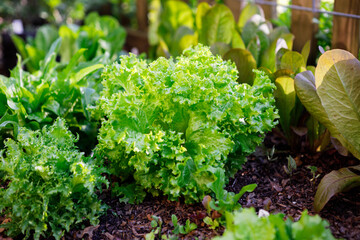How to Grow Endive (and Escarole) at Home
More and more people like to grow their own fruits and vegetables as a hobby, for self-satisfaction, and to control what they eat.
Endives are a great choice for backyard gardening. They are easy to grow, require minimum cost, and are a great source of nutrients for you and your family. However, growing fruits and vegetables in your backyard may be risky. There are some things you certainly need to avoid.
Endives are cool-season plants. If you grow them in warm areas, you shall know that they will probably form a flower stalk, and you will end up with an ornamental instead of a salad green! Thus, you should avoid growing it in areas with temperatures over 25 °C (77 °F). You can better plant your endives three weeks before the last frost date. The plant loves the sun but can tolerate some shade as well, maintaining relatively good growth and production. The minimum soil temperature for endive seed germination is 15 °C (59 °F); they generally germinate best at 20-22 °C (68-71 °F). While there are slow bolting endive varieties (resistant to bolting), you are advised to avoid stressing the plants, especially in warm areas. When the temperature is expected to rise above 24-25 °C (75-77 °F), you need to ensure sufficient water (irrigate). Shading and mulching could also help the plants endure the stress and avoid bolting.
The easiest method to grow endives is by seed. Consider buying your seeds from a legitimate seller to ensure they are disease-free, and directly sow them into their final positions. The best period to start sowing is during spring. All you have to do is remove any weeds, rocks or other unwanted materials from the soil. Then you can plow it slightly to mix it and improve its texture. You may also need to add some well-digested manure or compost to increase the soil’s nutrients. Subsequently, you may sow your seeds directly in the ground at 0,4 – 0,6 inches (1- 1.5 cm) depth. Consider making raised beds 20cm (8 inches) tall and 1m (3 ft ) wide to help them develop their root system. Generally, you will need 18-20 grams of seed per 100 ㎡ .
Alternatively, you may consider starting your cultivation indoors by sowing the seeds in seedbeds under controlled temperature and moisture conditions. A good technique is to cover them with sand to keep them moist. After a few days, you will need to transplant them into their final positions, keeping distances of 15 inches (40 cm.) between rows and 10 inches (30 cm.) between plants on the row. Irrigate thoroughly after transplanting.
Endives can tolerate drought. However, under water-stressed conditions, they increase their bitterness. Thus, you shall provide your endives with sufficient amounts of water. Most backyard farmers irrigate their endives once a day, often early in the morning.
As a fertilization method, you will need some manure or compost. The manure you may have integrated into the soil before planting will probably be sufficient for the growing season.
Most growers (both professionals and amateurs) choose to blanch their plants (protect the base and the inner leaves of the plants (heads) from sunlight) in order to decrease bitterness and improve flavor and texture. This process may start when the rows begin to “close”. To have the best results, you are advised to wait until the plant’s leaves are dry and tie the tops of the outer leaves. The closer the planting distances (around 20 cm or 8 inches), the higher the level of self-shading and self-blanch. Blanching of endive and escarole requires approximately 2-3 weeks.
Harvesting time depends on environmental conditions and you. You may wish to harvest endives when they are young to use them as baby greens. If so, the suitable period is after 40-50 days; by then, they will be 5cm (2 inches) long. Otherwise, you can harvest them fully grown after 60-80 days. A proper technique is to cut the rosette and not uproot the plant. Thus, you may collect a second yield.
Further Reading
10 Interesting Facts about Endive and Escarole
Endive and Escarole: Health Benefits and Nutritional Value
Endive & Escarole Plant Information and Environmental Requirements
How to Grow Endive (and Escarole) at Home
How to Grow Endive -Escarole for Profit
Endive (and Escarole) Soil Requirements, Preparation and Planting
Endive and Escarole Water Requirements & Irrigation Systems
Endive and Escarole Fertilization Requirements
Endive and Escarole Blanching, Yield, Harvest and Storage
Endive and Escarole Pests and Diseases
References:
- https://www.uaex.uada.edu/publications/PDF/FSA-6068.pdf
- https://www.uaex.uada.edu/counties/white/news/horticulture/Endive_Escarole.aspx
- https://aggie-horticulture.tamu.edu/archives/parsons/vegetables/endive.html
- http://www.gardening.cornell.edu/homegardening/scene79ad.html#varieties
- https://extension.umn.edu/vegetables/growing-lettuce-endive-and-radicchio#bolting-394965










































































